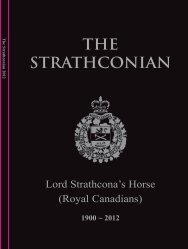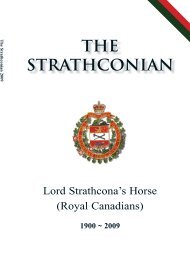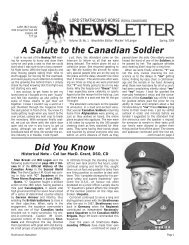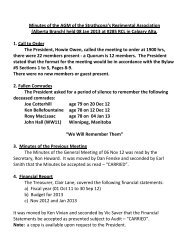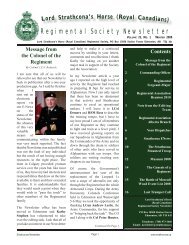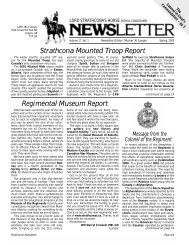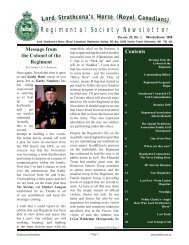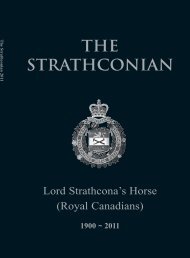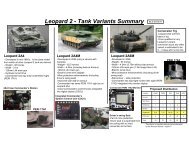The Regimental Manual Second Edition.pdf - Lord Strathcona's Horse
The Regimental Manual Second Edition.pdf - Lord Strathcona's Horse
The Regimental Manual Second Edition.pdf - Lord Strathcona's Horse
You also want an ePaper? Increase the reach of your titles
YUMPU automatically turns print PDFs into web optimized ePapers that Google loves.
REGIMENTAL MANUALHISTORY OF THE REGIMENT2. Major T.D.B. Evans, CB, DSO, first Commanding Officer of A Squadron Canadian MountedRifles, had served in South Africa with <strong>The</strong> Royal Canadian Dragoons (1 st Battalion Canadian MountedRifles Special Service Force) as had many of the other officers and men who formed the new unit.Lieutenants B.F. Mackie, DSO and H.D.B. Ketchen and others who were also transferred from BSquadron saw service in South Africa, but with Strathcona’s <strong>Horse</strong>.3. Under the command of Major Evans, A Squadron Canadian Mounted Rifles carried out theroutine duties of a peacetime permanent unit. A detachment was sent to the coronation of His MajestyKing Edward VII in 1902, and in 1903 the prefix “Royal” was added to the title and “A Squadron”dropped. 4 In 1907, Major A.C. Macdonell, DSO assumed command of <strong>The</strong> Royal Canadian MountedRifles.4. In October 1909 the Canadian Government decided to perpetuate the famous name “Strathcona’s<strong>Horse</strong>” in the Canadian Permanent Active Militia. <strong>The</strong> Royal Canadian Mounted Rifles were accordinglyre-designated Strathcona’s <strong>Horse</strong> (Royal Canadians). 5 <strong>The</strong> establishment was soon increased to twosquadrons and Colonel Steele, then commanding Military District No. 10 (Winnipeg), again tookcommand of the Regiment in addition to his other duties.5. <strong>The</strong> final change in the name of the Regiment came on 1 May 1911 when the prefix “<strong>Lord</strong>” wasadded 6 and that same year <strong>Lord</strong> Strathcona was appointed Honorary Colonel, a position he held until hisdeath in 1914. In 1912, the Regiment received its first Battle Honour “South Africa 1900-1901” 7 andMajor A.C. Macdonell was promoted to the rank of Lieutenant Colonel to assume command. During itstime in Winnipeg, the Regiment was garrisoned at Fort Osborne.ARTICLE 1102 - THE FIRST WORLD WAR1. At the outbreak of hostilities in 1914, the Regiment was mobilized and arrived at Valcartier on 19August, the first unit to arrive at the concentration area for the Canadian Expeditionary Force (CEF).After being brought up to war establishment strength by the addition of some 300 all ranks, the unitembarked at Quebec on 30 September and arrived in England on 16 October. Training commencedimmediately on Salisbury Plain, which was turned into a quagmire by the winter rains that continuedunabated for three months. <strong>The</strong>re was no shelter for the horses, and the men lived under canvas untilbillets were provided in January 1915.2. In March 1915 the Regiment joined the rest of the Canadian Cavalry Brigade, which consisted of<strong>The</strong> Royal Canadian Dragoons, <strong>Lord</strong> Strathcona’s <strong>Horse</strong> (Royal Canadians), 2 nd King Edward’s <strong>Horse</strong>and <strong>The</strong> Royal Canadian <strong>Horse</strong> Artillery. At this time, there was a need for more infantry in France andthe cavalry regiments volunteered to go into the trenches, leaving their mounts behind. <strong>The</strong> Brigadearrived in France on 4 May and the Regiment first came under fire on 22 May when it relieved the 10 thBattalion, CEF at Festubert. <strong>The</strong> Regiment subsequently fought in the action at Givenchy and was thentransferred to the line at Messines where it remained in its dismounted role until January 1916.4 General Order 153/1903, 1 October 1903.5 General Order 111/1909, October 1909: “His Majesty has been graciously pleased to approve the alteration of the title <strong>The</strong>Royal Canadian Mounted Rifles to that of ‘Strathcona’s <strong>Horse</strong> (Royal Canadians).’”6 General Order 68/1911, May 1911.7 General Order 230/1912, December 1912.1-3



